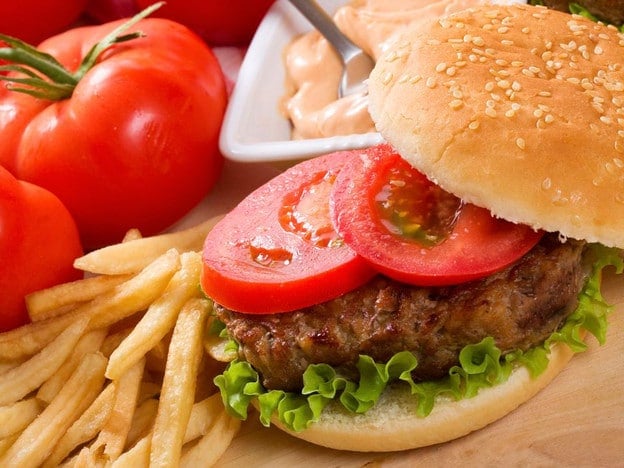
A soft, toasted bun… crisp, cool lettuce… sweet, vine-ripened tomatoes… and in the middle of it all, a juicy seasoned beef patty. Widely hailed as “America’s favorite food,” the history of the hamburger is filled with mythology. Many folks have claimed they were the first to place a ground beef patty between two slices of white bread. Who wouldn’t want to be responsible for inventing such a beloved American treat? Sadly, we don’t know who the true burger originator is. However, we do know a lot about how this classic sandwich gained a foothold in America, where billions are eaten each and every year.
A common misconception is that the first hamburger was created in Hamburg, Germany. While the inspiration for the hamburger came from Hamburg, the sandwich concept was invented much later. During the 19th century, Hamburg became famous for their beef, from cows raised in the regional countryside. Hamburg beef was commonly chopped, seasoned and molded into patties. Since refrigeration was not yet available, fresh beef like this had to be cooked immediately. Hamburg beef came with a hefty price tag outside of its native land, and was often substituted with less expensive varieties of beef.
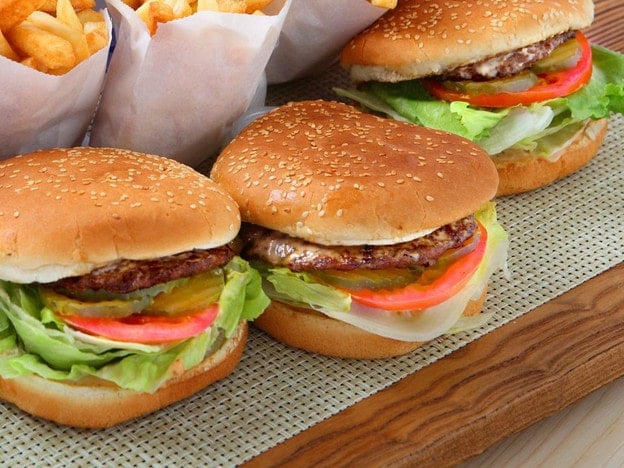
When groups of German immigrants began arriving in America during the 19th century, many earned their livelihood by opening restaurants in large cities like Chicago and New York. It wasn’t long before many of their menus featured an Americanized version of the Hamburg steak– beef that was minced or chopped and combined with garlic, onions, salt and pepper, then grilled or fried. In 1837, New York’s Delmonico’s restaurant offered a Hamburg steak on its first menu. At 10 cents it was the most expensive item, twice the cost of pork chops, veal cutlets and roast beef. A German restaurant at Philadelphia’s Centennial Exposition in 1876 served Hamburg steaks to thousands of customers. Afterwards the dish was in high demand, and could be found in non-German restaurants and in cookbooks like Mrs. Lincoln’s Boston Cook Book, published in 1884:
“Hamburgh Steak. – Pound a slice of round steak enough to break the fibre. Fry two or three onions, minced fine, in butter until slightly browned. Spread the onions over the meat, fold the ends of the meat together, and pound again, to keep the onions in the middle. Broil two or three minutes. Spread with butter, salt and pepper.”
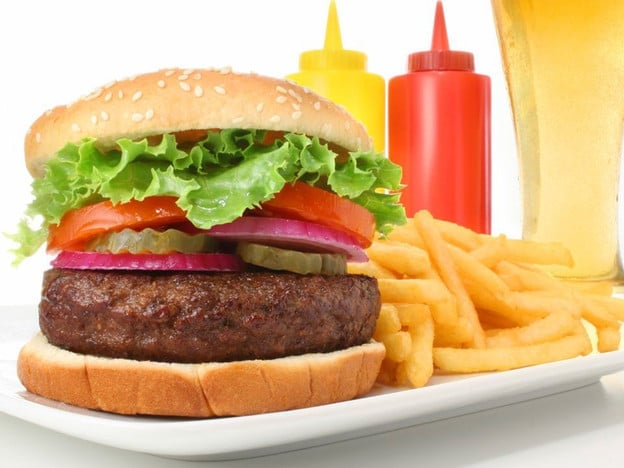
This is where Hamburg, Germany’s link to America’s classic hamburger ends. The difference between Hamburg steaks and hamburgers as we know them today is, quite simply, the bun. Two simple pieces of bread launched the Hamburg steak into nationwide popularity in the mid 1800’s, when many Americans found industrial jobs in factories. When steam powered factories began operating through the night hours, food carts offering coffee and small food items were often parked outside. Hungry workers would order food through a window and eat quickly before heading back inside to work. A few years later, when food carts came equipped with gas grills, Hamburg steaks started showing up on their menus. While well-liked by customers, the Hamburg steak proved difficult to eat while standing. Placing the patty between two slices of bread solved this problem, and the hamburger sandwich was born. Who was the first to serve the Hamburg steak as a sandwich? The details have been lost to history. Whoever it was, looking back it might be considered a stroke of culinary genius. By the turn of the century, the hamburger was already considered an American classic.
In 1921, Billy Ingram and Walter Anderson opened the first fast food hamburger establishment, White Castle, in Wichita, Kansas. Their main offering was a small 5-cent hamburger, which they encouraged customers to purchase “by the sack.” At that time, in part because of Upton Sinclair’s novel The Jungle, many Americans were concerned with the sanitary practices of the meat industry. White Castle addressed the fears of their customers by furnishing their clean, white-decorated restaurants with stainless steel countertops that could be easily wiped down. Their hamburger meat was ground in plain sight, ensuring patrons that they were paying for a quality meal. Around the same time hamburgers became a popular menu item at roadside diners and soda shops, where they were often served alongside french fries and milkshakes.
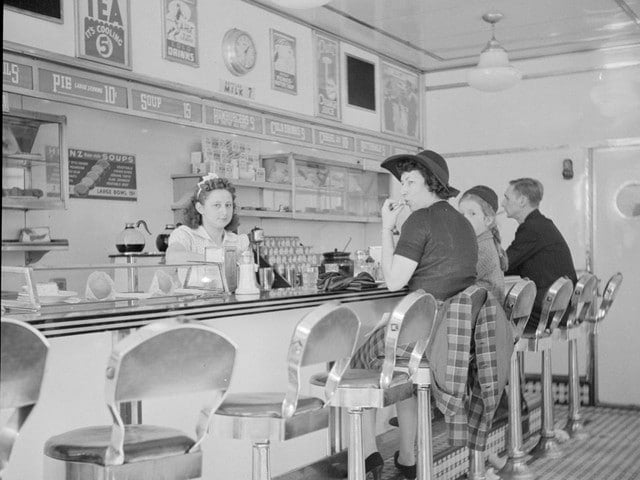
The hamburger continued to grow in popularity throughout the following decades, only suffering with the food shortages and meat rationing of World War II. During the war, American soldiers brought hamburgers overseas with them. They were easy to make and helped to cure some of the homesickness felt by the troops. When the McDonald brothers opened their Burger Bar Drive-In in San Bernardino, California in the 1940s, the hamburger made its official debut in the suburbs. By that late 1950s, McDonald’s had sold over 100 million hamburgers. Today, they sell over 75 hamburgers per second!
Today hamburgers can be found in nearly every part of the world. Over time the concept has evolved, and meat patties are decorated with an endless variety of creative, tasty toppings. The meat patties themselves have been replaced with healthier options, including black bean, turkey and salmon burgers (though one might argue that these do not really qualify as burgers in the traditional sense). Fast food establishments have also become more adventurous with their “hamburger” patties. At MOS burger in Japan you can order a rice burger, and McDonald’s in India developed a McAloo Tikki Burger made from fried potatoes and peas topped with tomatoes, onions and spicy condiments, to satisfy the dietary restrictions and taste preferences of their Hindu diners.
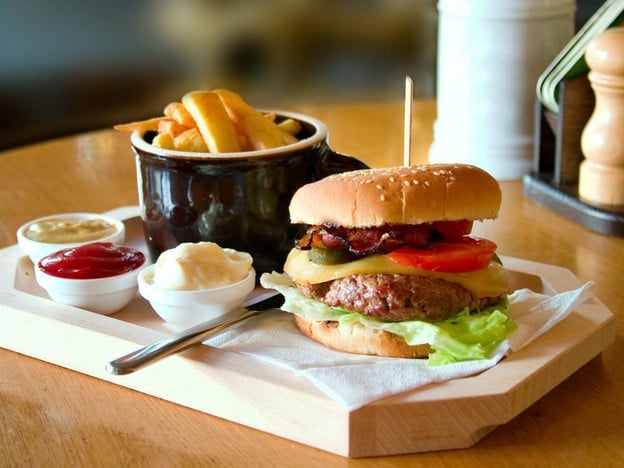
Throughout the years, hamburgers have endeared themselves to a variety of food lovers. Restaurants across the country compete for who can create the biggest hamburger, and culinarians write books devoted to cross-country road trips in search of the very best burger. You can find hamburgers in tiny hole-in-the-wall diners and on the menus of Michelin-starred restaurants. In 2005, Las Vegas restaurant Fleur de Lys outdid themselves by creating a $5,000 hamburger served with champagne. Seems a bit silly to me, but it does prove the widespread appeal of this simple and tasty sandwich. Even now they continue to evolve. Next, it appears that burgers will be grown in test tubes. I shudder to think.
What’s your favorite way to eat a hamburger?

Great Burger Recipe Ideas:
Tori Avey: Ima Burgers
Tori Avey: Spiced Up Turkey Burgers
Cooking on the Weekends: Spicy Grilled Sriracha Burgers with Crispy Shallots and Ginger-Chile Aioli
Weelicious: Salmon Burgers
Research Sources:
Lincoln, Mary J. (1833). Mrs. Lincoln’s Boston Cook Book – What to Do and What Not to Do In Cooking. Republished 2008, Applewood Books, Carlisle, Mass.
Lubin, Gus and Bedkar, Mamta (2011). 15 Facts About McDonalds That Will Blow Your Mind. Business Insider, Web. 4 Aug 2013.
Ozersky, Josh (2008). The Hamburger: A History. Yale University Press, US.
Smith, Andrew F. (2008). Hamburger: A Global History. Reaktion Books Ltd, London, UK.
Smith, Andrew F. (2007). The Oxford Companion to American Food and Drink. Oxford University Press, New York, New York.
We are a participant in the Amazon Services LLC Associates Program, an affiliate advertising program designed to provide a means for us to earn fees by linking to Amazon.com and affiliated sites. As an Amazon Associate I earn from qualifying purchases.



I totally agree that hamburgers have been favored by food lovers all over the world. Almost all of my friends are into burgers and I’m the only one who isn’t. I’m still hoping that I can find a beef burger restaurant that can please my tastebuds.
I think it’s cool that hamburgers were invented to solve a problem. I have had my experience with quick breaks, once I only had a five-minute break for the 12 hours I worked there. Eating quickly is a priority, so it’s interesting that hamburgers were invented just to be quick and easy to eat.
Hi Tory I loved the way you presented the history of hamburger but I would also like know the history of biryani a part of Indian cuisine
I will keep that in mind for a future post!
Very interesting.
For me this is a complete story: I am from Hamburg and yesterday I was at dinner with a french colleague and she told me that the hamburger has been invented in Hamburg. I answered that it s not true but we like to tell that everywhere. Today she sent me the link to your story as a proof that she was more or less right.
Btw. we were in a restaurant called Brooklyn Burger Bar eating excellent hamburgers and french fries!
The guy on Weathernation channel this morning stated hamburger was invented in Hamburg, NY. So I was curious and did some research. Still can’t figure out where it was invented…lol
You say that the history of when the hamburg steak was lost to history, this is not entirely true. There appear to be a number of claims in this country as to who and when the first hamburger sandwich was created. However by most definitions a hamburger is a ground beef patty between a toasted bun, this was in fact created in Tulsa approximately 1891 by Oscar Weber Bilby. In fact the family has carried on the tradition in Tulsa, with the original grill used by Oscar in 1891, except that now instead of the heat source being wood it is now gas fired.
You said “While the inspiration for the hamburger came from Hamburg, the sandwich concept was invented much later.” I just don’t get that part.
Meaning, the hamburg steak started in Hamburg, but the concept of putting a hamburg steak inside bread or a bun came later.
Nice! Plenty of info my my ISU but found a possible mistake. You said “German immigrants began arriving in America during the 19th century” but went to talk about German settler stores opening up in the early 18th century. Just thought I comment about that.
There is no mention of the 18th century. Rather, there is a mention of restaurants opening in the 1800’s. The 19th century refers to the period between 1801-1900.
omg burgers are life
I usually don’t comment on things like this, but you did a great job describing the history of the hamburger. I got so hungry that I had to go make food!
I was hungry while writing it Krista! LOL
Your welcome . where are you from?
Hi Tori,
your website is very attractive and I very enjoyed. I like hamburger.
Thanks Bahar!
this history really benefited me as i am doing a assignment abt this hope i get really good results and i love hamburgers
🙂
My dad was the accountant at a little joint in Greenwich Village called Pam-Pam. One time mom and I were with him when he had to drop off some papers. Dad said we should stay and eat because they had terrific burgers. So, we sat at the counter and ordered from the owner – nothing fancy, just a plain hamburger. I still remember (about 40 years later) the juices dripping down my hand onto the plate, and the lusciousness of the burger. I liked mine simple (and still do) so I know that the only thing I would have put on it would have been a little ketchup. It needed no more to make it memorable.
We’ve tried to make one that good, and we do ok, but nothing has really come close to a Pam-Pam hamberger.
What about Seymour WI HUH?
You are referring, of course, to Charlie Nagreen and his claim that he was the inventor of the hamburger. There are many similar stories from across the country, however Hamburg steaks were being sold in sandwich form prior to 1885 (when Nagreen supposedly invented them). Many would like to take credit for the invention, however there is no firm consensus on the very first time a beef patty was sandwiched between two buns. I think many creative cooks (including Charlie Nagreen) deserve credit for being some of the first to recognize that a Hamburgh steak tastes good between two slices of bread, but most historians agree that Charlie is not the original creator of the hamburger. That information has sadly been lost to history.
Whitecastle who happens to be the first fast food restaurant in history, traced the hamburger to a German fisherman named Otto Krauss who asked if he could get a hamburg steak beetween two slices of bread, because it was difficult to eat a hot steak while out on a fishing trip. The common misconception is not that the hamburger was invented in Germany, it was invented in Germany. The common misconception is that Charlie invented the hamburger, he did not. Charlie invented the cheeseburger.
According to my research these stories and anecdotes are all debatable. But fun to speculate.
You talk about the history and don’t mention Louis’ Lunch in New Haven?
If I had covered every single burger joint that has claimed to be the inventor of the hamburger, it would have been a very long article indeed. You’d be surprised how many restaurants and families claim they were the first. I don’t doubt Louis believed he had come up with something entirely new (and for him and his customers, it was), however 1900 was not the first time a Hamburgh steak was served as a sandwich. Truth is, burgers were being served decades before Louis’ Lunch served them, on pushcarts outside factories on the East Coast.